1. Introduction
The primary issue to solve is the relationship existing between the number of Hamiltonian cycles, labeled as \( {\ \ \ _{H}} \) , and generating sets \( S \) of directed Cayley graphs \( DiCay(G:S) \) (Tripi[2]) of a Group \( G \) . Motivated by the conjecture that there is a hamiltonian circuit in every Cayley digraph on a dihedral group (Holsztyński and Strube[3]), we demonstrated that if \( S=r \) and \( s \) , the directed Cayley graph of Dihedral groups \( {D_{2n}} \) will consist of \( n \) Hamiltonian cycles. In addition, we provided evidence indicating that \( {\ \ \ _{H}}(DiCay({D_{2n}}:S))=2 \) is consistently present with \( S \) under certain conditions. Inspired by Cayley’s Theorem Extended (STELOW[4]), it is our objective to offer a generalization of the principles found in Dihedral groups to Symmetric groups. For Symmetry groups of Platonic solids and Symmetric groups, we encountered difficulty in deriving a general rule. Nevertheless, based on graphical evidence, we came up with some conjectures. This paper is organized by treating each of the cases in order, starting with Dihedral groups, followed by Symmetry groups of Platonic solids and Symmetric groups.
2. Dihedral Groups
THEOREM 2.1: If the generating set of \( DiCay({D_{2n}}:S) \) is in the form of \( {r^{i}} \) and \( s{r^{j}} \) with \( r \) and \( s \) as the preliminary elements, where \( 0≤i≤n-1 \) , \( 0≤j≤n-1 \) , then there exists at least one Hamiltonian cycle in this graph.
Proof: Given the fundamental symmetries, specifically \( r \) and \( s \) , within the Dihedral groups, it follows that \( {D_{2n}} \) can be expressed as the set \( e,r,{r^{2}},...,{r^{n-1}},s,sr,s{r^{2}},...,s{r^{n-1}} \) with each element corresponding to a composition of these symmetries. In the directed Cayley graph representation of \( {D_{2n}} \) with the generating set of \( r \) and \( s \) , \( r \) will form 2 distinct cycles of length \( n \) , and \( s \) segregate the elements into pairs with \( \frac{n}{2} \) elements in each pair. The bidirectional edge connects the two vertices in each pair. Considering that \( DiCay({D_{2n}}:r,s) \) possesses a minimum of one Hamiltonian cycle, it can be inferred that more elements in the generating sets will always form at least one Hamiltonian cycle in the graph.
EXAMPLE 2.2: A concrete example is provided by Figure 1:
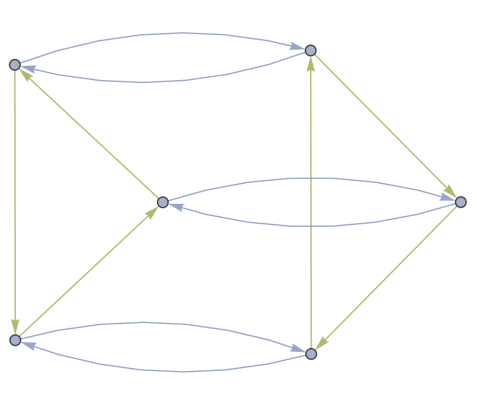
Figure 1. The directed Cayley graph of \( {D_{6}} \) with the generating set of \( r \) and \( s \) .
THEOREM 2.3: The number of Hamiltonian cycles of the directed Cayley graph of Dihedral groups with the generating set of \( r \) and \( s \) is n. i.e.:
\( {\ \ \ _{H}}(DiCay({D_{2n}}:r,s)) = n \ \ \ (1) \)
Proof: In a geometric approach, we can establish the proof for this theorem. Let us consider the \( DiCay({D_{2n}}:r,s) \) structure. As illustrated in Figure 2, when the generator \( r \) is applied, it forms an \( n-gon \) . Additionally, by multiplying each vertex in the \( n-gon \) with \( s \) , we can extend it to include \( n \) bidirectional edges. Consequently, the \( DiCay({D_{2n}}:r,s) \) structure consists of both an inner and an outer \( n-gon \) . To identify the Hamiltonian cycles within this structure, we can initiate our journey from the identity element and traverse through the inner \( n-gon \) until we reach the vertex \( {r_{n-1}} \) . From there, we move to the outer \( n-gon \) using one of the bidirectional edges and proceed in the opposite direction along the \( n-gon \) . Eventually, we arrive at the vertex \( s \) . Only one edge permits us to return to the identity element. Moreover, the Cayley graph possesses symmetry through a rotation of \( \frac{2π}{n} \) , thereby ensuring the existence of precisely \( n \) Hamiltonian cycles in Figure 2:
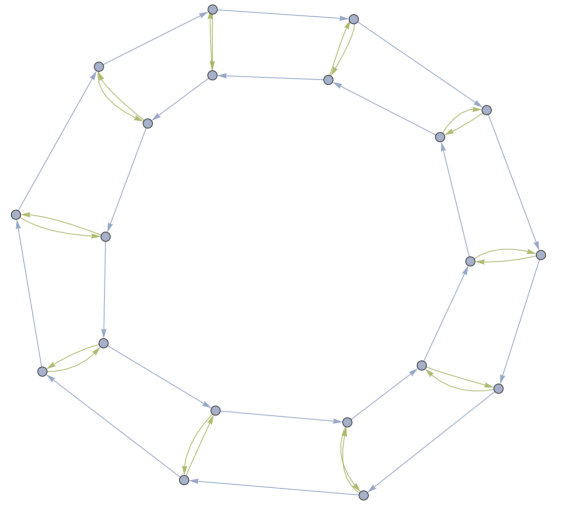
Figure 2. The directed Cayley graph of \( {D_{2n}} \) with the generating set of \( r \) and \( s \)
EXAMPLE 2.4: According to the observations illustrated in Figure 3, it is evident that by adhering to the procedures outlined in the proof, the initial vertex can be chosen from among \( e \) , \( r \) , \( {r^{2}} \) , and \( {r^{3}} \) . This leads to the conclusion that the existence of four Hamiltonian cycles is guaranteed.
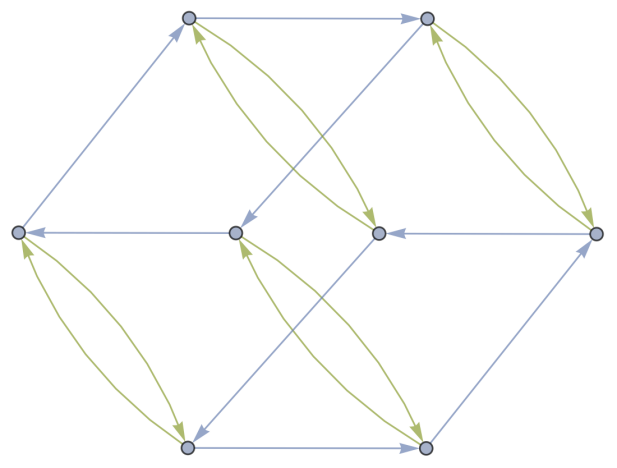
Figure 3. The directed Cayley graph of \( {D_{8}} \) with the generating set of \( r \) and \( s \)
THEOREM 2.5: In directed Cayley graphs of Dihedral groups generated by the elements \( s{r^{i}} \) and \( s{r^{j}} \) , where \( 0≤i≤n-1 \) , \( 0≤j≤n-1 \) , and \( i≠j \) , the situation where
\( {\ \ \ _{H}}(DiCay({D_{2n}}:s{r^{i}},s{r^{j}}))=2 \ \ \ (2) \)
Proof: Given the generating elements \( s{r^{i}} \) and \( s{r^{j}} \) , it is evident that each element will produce \( \frac{n}{2} \) pairs of bidirectional edges that link two vertices. By Induction:
Base Case: \( {\ \ \ _{H}}(DiCay({D_{6}}:s,sr))=2 \)
Suppose \( {\ \ \ _{H}}(DiCay({D_{2n}}:s{r^{i}},s{r^{j}}))=2 \) :
By performing a left multiplication of \( s{r^{i}} \) and \( s{r^{j}} \) , the vertices on the Cayley graphs are transformed into \( e,s{r^{i}},{s^{2}}{r^{i-j}},{s^{3}}{r^{2i-j}}...,{s^{2n}}{r^{n(i-j)}} \) .
The equation \( {s^{2n}}{r^{n(i-j)}}=e \) implies that the vertices form a closed cycle connected by bidirectional edges. In \( (DiCay({D_{2(n+1)}}:s{r^{i}},s{r^{j}})) \) , the vertices are interconnected in the same manner as in \( (DiCay({D_{2}}n:s{r^{i}},s{r^{j}})) \) . The final vertex is denoted as \( {s^{2n+2}}{r^{(n+1)(i-j)}} \) .
It is required to demonstrate that
\( {s^{2n+2}}{r^{(n+1)(i-j)}}=e \ \ \ (3) \)
and,
\( {s^{2n+2}}={s^{2(n+1)}}=e \ \ \ (4) \)
Since \( {r^{n+1}}=e \) in \( (DiCay({D_{2(n+1)}}:s{r^{i}},s{r^{j}})) \) , it follows that \( {r^{(n+1)(i-j)}}=e \) .
Therefore, \( {s^{2n+2}}{r^{(n+1)(i-j)}}=e \) .
\( {\ \ \ _{H}}(DiCay({D_{2n+2}}:s{r^{i}},s{r^{j}}))=2 \) .
EXAMPLE 2.6: A prominent instance can be observed in Figure 4, which has 2 Hamiltonian cycles.
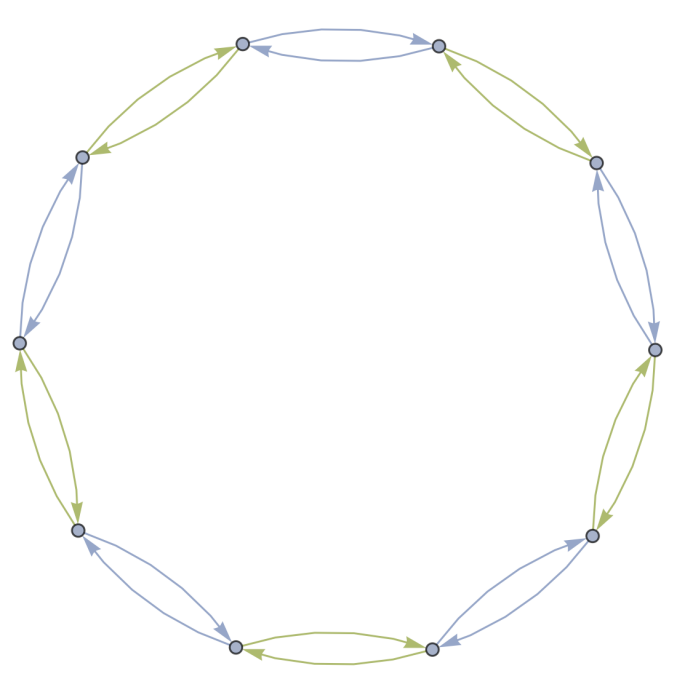
Figure 4. The directed Cayley graph of \( {D_{10}} \) with the generating set of \( (14)(23) \) and \( (12)(35) \)
3. Platonic Solids and Symmetric Groups
CONJECTURE 3.1: There are no Hamiltonian cycles in the directed Cayley graph of the Symmetry group of Platonic solids with the generating set r, s.
EXAMPLE 3.2: In the case of the Tetrahedral group T, which possesses 12 elements, \( {\ \ \ _{H}}(DiCay(T:(123),(12)(34))=0 \) . As the quantity of elements escalates, it becomes increasingly challenging to procure a Hamiltonian cycle. As it is shown in Figure 5:
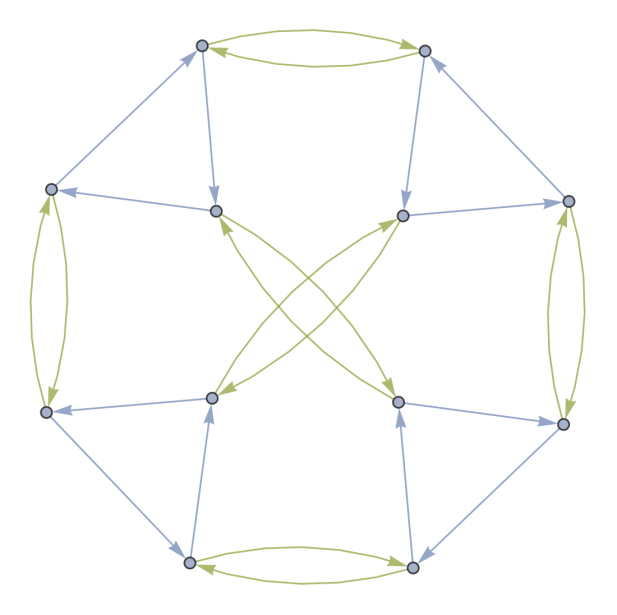
Figure 5. The directed Cayley graph of the Tetrahedral group \( T \) with the generating set of \( (123) \) and \( (12)(34) \)
CONJECTURE 3.3: In the directed Cayley graph of Symmetric groups, it has been observed that the generating set of \( (12) \) and \( (12...n) \) can solely yield a Hamiltonian cycle when \( n≠4 \) .
EXAMPLE 3.4: As shown in Figure 6, there exist Hamiltonian cycles.
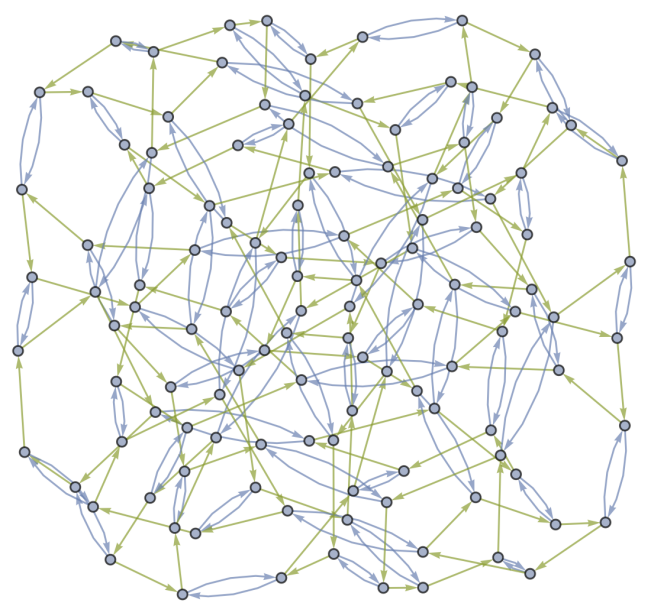
Figure 6. The directed Cayley graph of \( {S_{5}} \) with the generating set of \( (12) \) and \( (12345) \)
4. Final Remarks
In previous researches on Hamiltonian cycles, A. Heus and D. Gijswijt [5] proved that there exists at least one Hamiltonian cycle in the directed Cayley graph of Symmetric groups if the generating set includes only transpositions.
5. Conclusion
In the first section of this work, we initiated our study by considering the existence of Hamiltonian cycles in Dihedral groups. We proved that the directed Cayley graph of a Dihedral group will have at least one Hamiltonian cycle if the generating sets is in the form of \( {r^{i}} \) and \( s{r^{j}} \) with \( r \) and \( s \) as the preliminary elements. Additionally, we proved \( {\ \ \ _{H}} \) \( (DiCay({D_{2n}}:r,s)) \) = \( n \) , which is a generalization in Dihedral groups. Subsequently, we proceeded to explore the specific case in which the generating set of the directed Cayley graphs of Dihedral groups is in the form of \( s{r^{i}} \) and \( s{r^{j}} \) and prove that \( {\ \ \ _{H}}(DiCay({D_{2n}}:s{r^{i}},s{r^{j}}))=2 \) always exists. In the other section, we proposed conjectures regarding the existence of Hamiltonian cycles in Symmetry groups of Platonic solids and Symmetric groups.
Drawing upon the theorems presented in this paper, it is hopeful that this finding will contribute to addressing further problems regarding the relationship between the number of Hamiltonian cycles and generating sets in the general Symmetric groups.
References
[1]. Meier, J. (2008). Cayley’s Theorems. In Groups, Graphs and Trees: An Introduction to the Geometry of Infinite Groups (London Mathematical Society Student Texts, pp. 1-43). Cambridge: Cambridge University Press. doi:10.1017/CBO9781139167505.002
[2]. Tripi, Anna, “Cayley Graphs of Groups and Their Applications” (2017). MSU Graduate Theses. 3133. https://bearworks.missouristate.edu/theses/313
[3]. Holsztyński, W., & Strube, R. F. E. (1978). Paths and circuits in finite groups. Discrete Mathematics, 22(3), 263-272.
[4]. STELOW, M. (2017). HAMILTONICITY IN CAYLEY GRAPHS AND DIGRAPHS OF FINITE ABELIAN GROUPS.
[5]. Heus, A., and Gijswijt, D. (2008). A study of necessary and sufficient conditions for vertex transitive graphs to be Hamiltonian.
Cite this article
Jiang,Z. (2024). The number of Hamiltonian cycles in groups of Symmetry. Theoretical and Natural Science,43,1-5.
Data availability
The datasets used and/or analyzed during the current study will be available from the authors upon reasonable request.
Disclaimer/Publisher's Note
The statements, opinions and data contained in all publications are solely those of the individual author(s) and contributor(s) and not of EWA Publishing and/or the editor(s). EWA Publishing and/or the editor(s) disclaim responsibility for any injury to people or property resulting from any ideas, methods, instructions or products referred to in the content.
About volume
Volume title: Proceedings of the 3rd International Conference on Computing Innovation and Applied Physics
© 2024 by the author(s). Licensee EWA Publishing, Oxford, UK. This article is an open access article distributed under the terms and
conditions of the Creative Commons Attribution (CC BY) license. Authors who
publish this series agree to the following terms:
1. Authors retain copyright and grant the series right of first publication with the work simultaneously licensed under a Creative Commons
Attribution License that allows others to share the work with an acknowledgment of the work's authorship and initial publication in this
series.
2. Authors are able to enter into separate, additional contractual arrangements for the non-exclusive distribution of the series's published
version of the work (e.g., post it to an institutional repository or publish it in a book), with an acknowledgment of its initial
publication in this series.
3. Authors are permitted and encouraged to post their work online (e.g., in institutional repositories or on their website) prior to and
during the submission process, as it can lead to productive exchanges, as well as earlier and greater citation of published work (See
Open access policy for details).
References
[1]. Meier, J. (2008). Cayley’s Theorems. In Groups, Graphs and Trees: An Introduction to the Geometry of Infinite Groups (London Mathematical Society Student Texts, pp. 1-43). Cambridge: Cambridge University Press. doi:10.1017/CBO9781139167505.002
[2]. Tripi, Anna, “Cayley Graphs of Groups and Their Applications” (2017). MSU Graduate Theses. 3133. https://bearworks.missouristate.edu/theses/313
[3]. Holsztyński, W., & Strube, R. F. E. (1978). Paths and circuits in finite groups. Discrete Mathematics, 22(3), 263-272.
[4]. STELOW, M. (2017). HAMILTONICITY IN CAYLEY GRAPHS AND DIGRAPHS OF FINITE ABELIAN GROUPS.
[5]. Heus, A., and Gijswijt, D. (2008). A study of necessary and sufficient conditions for vertex transitive graphs to be Hamiltonian.









